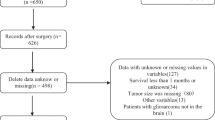Background:
To identify prognostic factors for overall survival in patients with newly diagnosed glioblastoma undergoing radiation therapy.
Patients and Methods: From January 1980 to June 2000, we treated 432 consecutive patients with glioblastoma at out institution. 17 patients were excluded from the analysis for various reasons. Mean age of the 415 patients who were included in the study was 59 years (19–81 years), Karnofsky performance status (KPS) was ≥ 70 in 280 patients. 343 patients underwent resection, 72 had a biopsy. Various fractionation schemes were used (conventional fractionation, n = 112; hypofractionation, n = 94; accelerated hyperfractionation, n = 209). Survival probabilities were estimated using the method of Kaplan and Meier. Multivariate analysis was done with a Cox regression model.
Results: By July 2001, 406 patients had died. Medial overall survival was 8.2 months. Of ten factors considered in a proportional hazards model stratified for treatment (fractionation scheme and type of surgery), significant variables in a multivariate model were age (50–64 years vs < 50 years [RR 1.35; 95% CI 1.02–1.78], ≥ 65 years vs < 50 years [RR 2.08; 95% CI 1.54–2.81]), performance status (KPS < 70 vs ≥ 70 [RR 1.53; 95% CI 1.23–1.90]), and central tumor location (yes vs no [RR 1.39; 95% CI 1.04–1.87]). Blood hemoglobin (Hb) values were available in 318 patients and serum lactate dehydrogenase (LDH) levels in 234 patients. 89 patients were anemic (Hb men < 13 g/dl, women < 12 g/dl), in 80 patients the LDH level was raised beyond the upper limit of the normal range (> 240 U/l). By including the three significant variables, both parameters had an additional significant effect with an estimated relative risk of about 1.4 in their corresponding subgroups.
Conclusion: Besides established prognostic factors, anemia and raised serum LDH levels may negatively influence outcome in glioblastoma patients. Our results from data-dependent modeling have to be confirmed by independent studies.
Hintergrund:
Die vorliegende Studie untersucht Prognosefaktoren für das Gesamtüberleben bei Patienten, die aufgrund eines neu diagnostizierten Glioblastoms bestrahlt wurden.
Patienten und Methodik: Von Januar 1980 bis Juni 2000 wurden 432 Glioblastompatienten an unserer Klinik behandelt. 415 Patienten wurden in die Analyse einbezogen. Das durchschnittliche Alter betrug 59 Jahre (19–81 Jahre), der Karnofsky-Performance-Status (KPS) war bei 280 Patienten ≥ 70. Bei 343 Patienten wurde der Tumor reseziert, bei 72 Patienten biopsiert. Die Strahlentherapie erfolgte konventionell fraktioniert (n = 112), hypofraktioniert (n = 94) oder akzeleriert hyperfraktioniert (n = 209). Die Schätzung der Überlebenswahrscheinlichkeiten erfolgte mit der Methode von Kaplan und Meier. Multivariate Analysen wurden mit einem Regressionsmodell nach Cox durchgeführt.
Ergebnisse: Bis Juli 2001 waren 406 Patienten verstorben. Das mediane Gesamtüberleben betrug 8,2 Monate. Von zehn Faktoren, die in einem nach Resektionsstatus und Fraktionierungsschema stratifizierten Proportional-Hazards-Modell untersucht wurden, erwiesen sich als signifikant: Alter (50–64 Jahre vs. < 50 Jahre) [RR 1,35; 95%-CI 1,02–1,78], ≥ 65 Jahre vs. < 50 Jahre [RR 2,08; 95%-CI 1,54–2,81]), Allgemeinzustand (KPS < 70 vs. ≥ 70 [RR 1,53; 95%-CI 1,23–1,90]) und zentraler Tumorsitz (ja vs. nein [RR 1,39; 95%-CI 1,04–1,87]). Werte für Hämoglobin (Hb) und Serum-Lactat-Dehydrogenase (LDH) lagen bei 318 bzw. 234 Patienten vor. 89 Patienten waren anämisch (Hb Männer < 13 g/dl, Frauen < 12 g/dl), bei 80 Patienten war der LDH-Wert erhöht (> 240 U/l). Unter Berücksichtigung der drei signifikanten Variablen übten beide Parameter in den jeweiligen Untergruppen einen zusätzlichen Effekt aus mit einem relativen Risiko von etwa 1,4.
Schlussfolgerung: Neben bekannten Prognosefaktoren beeinflussen erniedrigte Hb- und erhöhte LDH-Werte das Überleben bei Patienten mit Glioblastom negativ.
Similar content being viewed by others
Author information
Authors and Affiliations
Additional information
Received: February 11, 2002; accepted: August 2, 2002
Correspondence Address Johannes Lutterbach, MD, Department of Radiotherapy, Radiologic University Hospital, Hugstetter Straße 55, 79106 Freiburg i. Br., Germany, Phone (+49/761) 270-3862, Fax -3924, e-mail: lutterba.@mstl.ukl.uni-freiburg.de
Rights and permissions
About this article
Cite this article
Lutterbach, J., Sauerbrei, W. & Guttenberger, R. Multivariate Analysis of Prognostic Factors in Patients with Glioblastoma. Strahlenther Onkol 179, 8–15 (2003). https://doi.org/10.1007/s00066-003-1004-5
Issue Date:
DOI: https://doi.org/10.1007/s00066-003-1004-5




